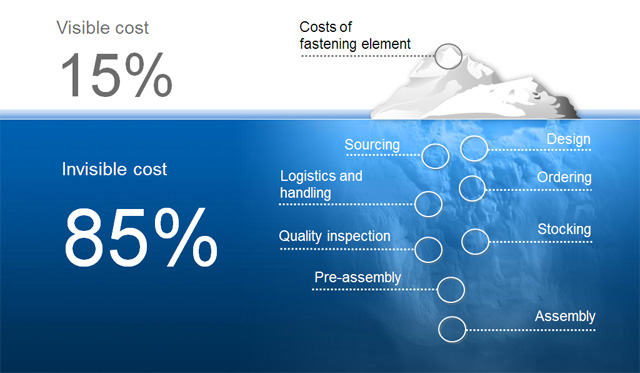When looking to improve productivity and control or possibly lower cost, the total in place cost must be evaluated.
The 85/15 theory can be applied to any situation. The question may change from “where do I spend most of my time?” in regards to the tasks at hand to “where do I spend most of my revenue in regards to the task of generating a profit?”
Simply put, 15 percent of the carpet in our homes receives 85 percent of the traffic, so when we look at total cost of the carpet we have to realize that we have paid for a great deal for carpet that isn’t used and the smaller area of the carpet is actually costing more than anticipated.
To better visualize the TCO model in fastening, we also often use the iceberg model.
In manufacturing, the cost of the individual part gains the most attention. However, the entire requirements for the final assembly of the unit should be evaluated before being priced and sent to the market place.
The processes of evaluating the final assembled product should start from the finished unit and work backwards.
1. How many parts in the assembly are similar in style finish and functions?
2. How many different quality tests and steps are required for the finished unit?
3. How many times are the parts touched before they reach the assembly point?
4. How many steps are required for the final assembly of the unit?
5. How many parts are installed and how many different tools are required?
6. Are the works stations set up in user friendly manner or do they create fatigue and mistakes?
7. Can the assembly be finished in a consistent manner, any time of day by any assembler?
8. Can the assembly be performed consistently and interchangeably in a global arena?
9. Can the parts be purchased and supplied to a global industry standard?
10. Is the design and performance of the assembly conducive to a long market life span?
The key to control cost and lower overall cost is to evaluate the avoidable waste of the assembly. After that, you can better design parts and proses that will control or remove waste from the entire product.
To learn more about the total cost of ownership, contact us at ProvenProductivity@bossard.com.
Total Cost of Ownership by Bossard




